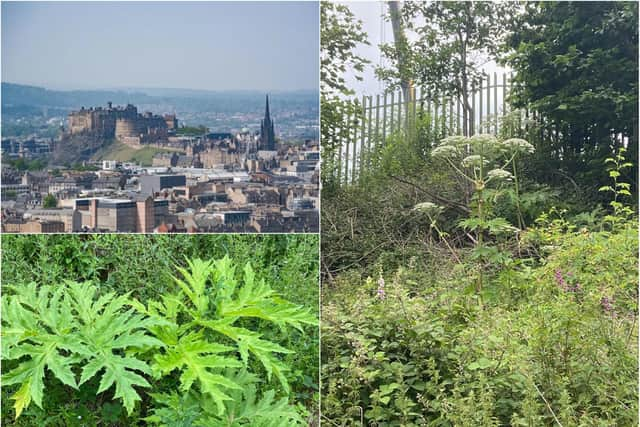Here are Edinburgh's recorded hotspots for toxic giant hogweed plant which can blind and scar, as 80 reports made since 2018
and live on Freeview channel 276
And following recent concerns about giant hogweed growing on either side of a cycle path near industrial buildings just south of Gilmerton (not on council land), the Evening News asked the local authority for some of their known hotspots for the invasive species across the city.
The information, released under freedom of information laws, also shows that 80 reports have been made to the council since the start of 2018 about the weed, which can grow to a height of several metres and looks like a giant parsley stalk.
Advertisement
Hide AdAdvertisement
Hide AdAmong these reports, two people suffered injuries - one with blisters and another with an arm injury.


The city council has a controlled programme for giant hogweed and a team is responsible for responding to all reported incidents, as well as for controlling Japanese knotweed.
Giant hogweed was introduced to Scotland by horticulturalists as an ornamental plant in the 19th century - but it soon spread out of control.
Landowners are responsible for any giant hogweed growing on their land.
Advertisement
Hide AdAdvertisement
Hide AdIt is thought the coronavirus lockdown restrictions may have made managing the weed more difficult for those who would normally do so, allowing for the possibility of it spreading more quickly.
But figures released by the council under freedom of information on Tuesday show that 12 reports concerning giant hogweed were made in July, the same number as July last year.
Only 20 giant hogweed reports were made in Edinburgh this year compared to 36 last year and 24 in 2018, although it should be noted that lockdown has meant people leaving the house less often and for less time.
Giant hogweed ‘hotspots’
The council's information officer said reports made through their central records system are recorded but that those made to their parks and greenspace service are not.
Advertisement
Hide AdAdvertisement
Hide AdHere are the giant hogweed locations in Edinburgh which have been recorded by the local authority;
Abbey Mount
Calder Road
Castle Gogar Rigg
Duddingston Road West
Eildon Street
Gordon Terrace
Gyle Park
Harrison Park East
Magdalene Glen
Norton Mains
Restalrig Circus
Restalrig Square
Seafield Street
Southhouse Road
Telferton
Tennant Street
West Savile Terrace
What to do if you touch giant hogweed
Stan Whitaker, Scottish Natural Heritage (SNH) advisor on invasive, non-native species, told the Evening News last month that giant hogweed is an issue in some areas of Scotland and urged landowners to to control it whenever possible - and come to them for advice if necessary.
Giant hogweed is not native to the UK and originates from the Caucasus Mountains and Central Asia.
According to the Woodland Trust website, it can now be found throughout much of the UK and often colonises river banks where its seeds are transported by the water. A good identifier of the species is its jagged leaves and green stems with purple blotches and stiff, white hairs. They also have a thick circle of hairs at the base of each leaf stalk.
Advertisement
Hide AdAdvertisement
Hide AdThe Woodland Trust’s advice, if you do get giant hogweed sap on your skin, is to wash the area thoroughly immediately, seek medical advice and to not expose the area to sunlight for a few days.
Chemicals in the sap can cause photodermatitis or photosensitivity, where the skin becomes very sensitive to sunlight and may suffer blistering, pigmentation and long-lasting scars.
According to several media reports in 2015, at least five children were left with severe burns after coming into contact with the plant in parks in Greater Manchester.
A message from the Editor:
Thank you for reading this story on our website. While I have your attention, I also have an important request to make of you.
Advertisement
Hide AdAdvertisement
Hide AdThe dramatic events of 2020 are having a major impact on many of our advertisers - and consequently the revenue we receive. We are now more reliant than ever on you taking out a digital subscription to support our journalism.
Subscribe to the Edinburgh Evening News online and enjoy unlimited access to trusted, fact-checked news and sport from Edinburgh and the Lothians. Visit https://www.edinburghnews.scotsman.com/subscriptions now to sign up.
By supporting us, we are able to support you in providing trusted, fact-checked content for this website.
Joy Yates
Editorial Director